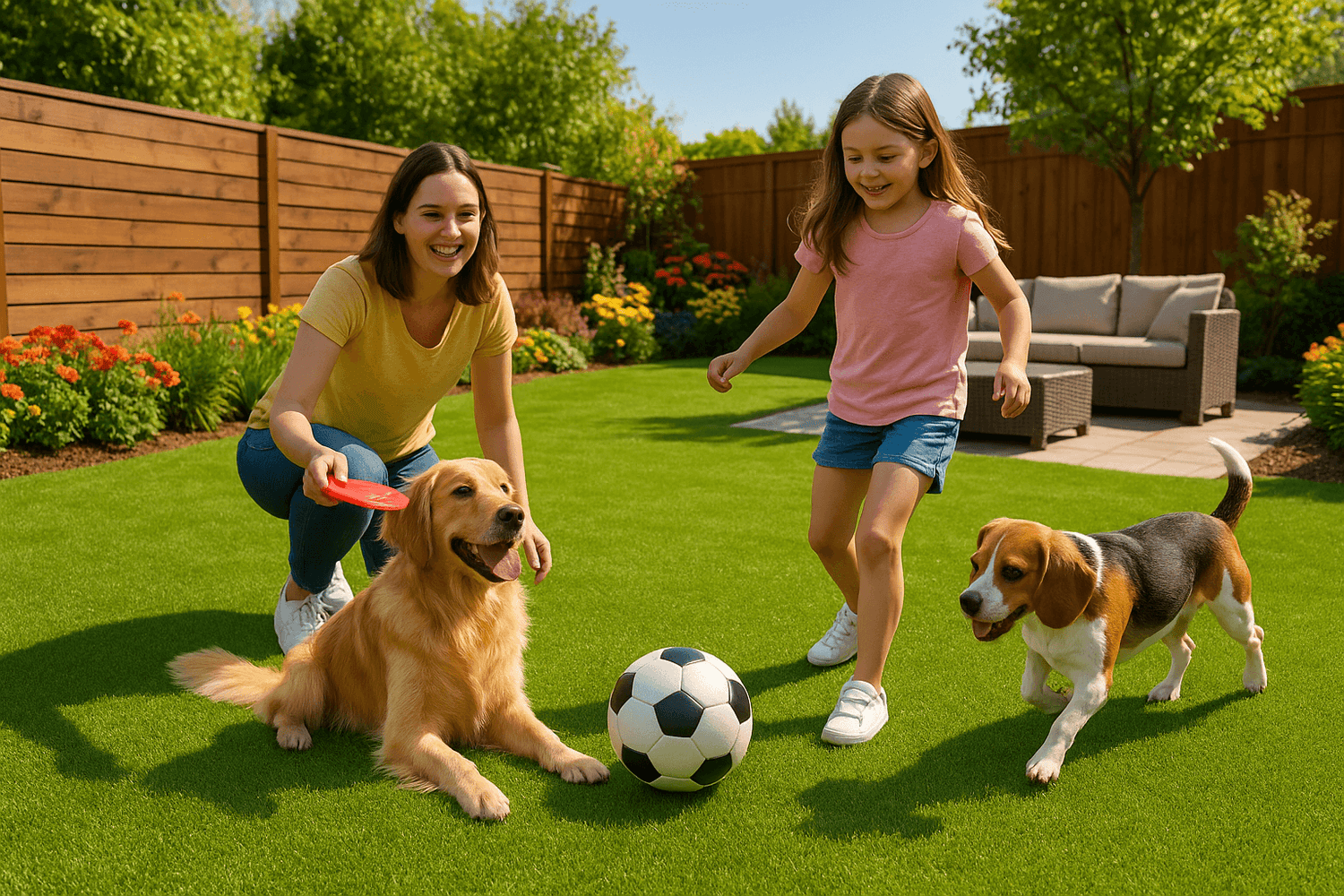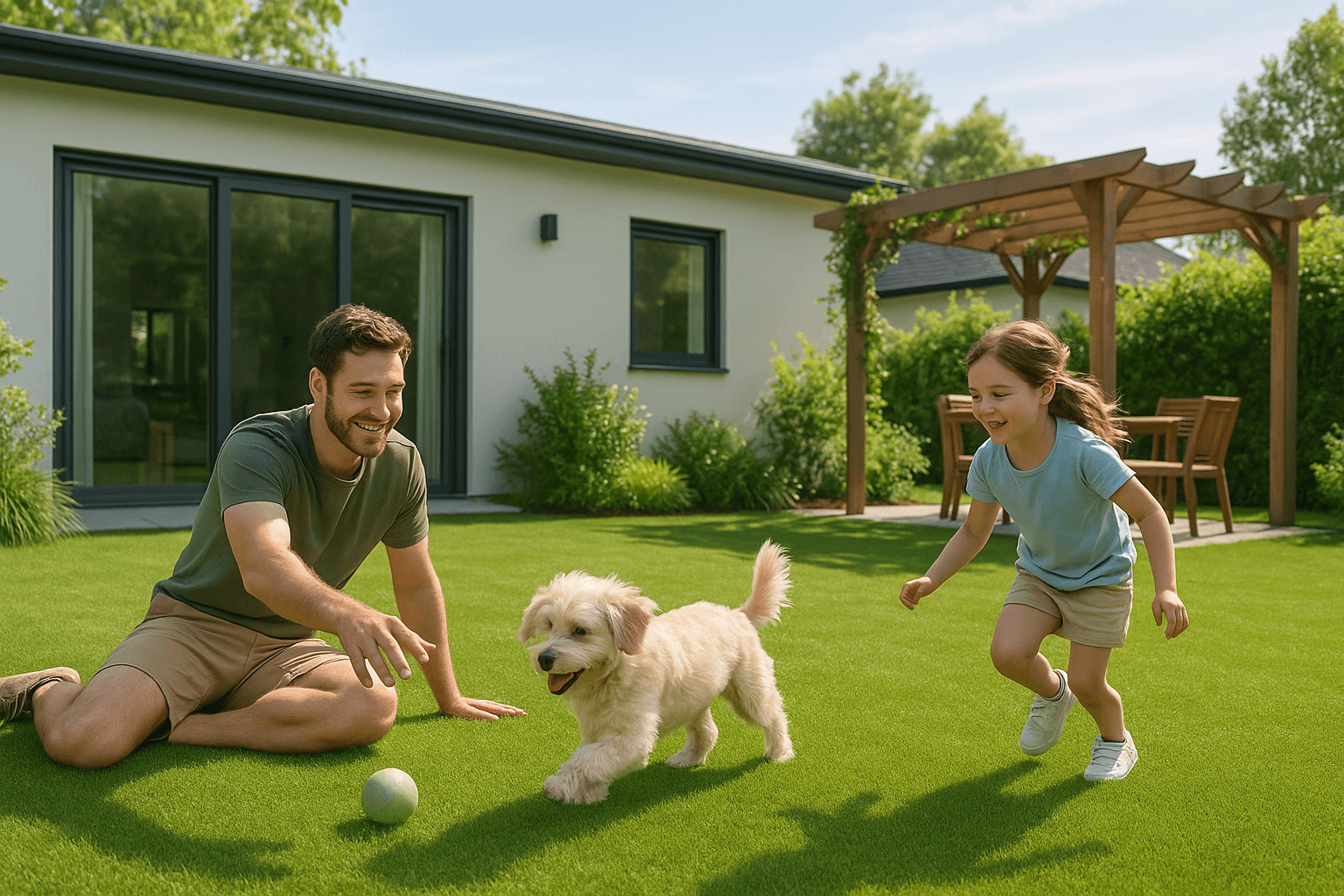More people today are choosing outdoor artificial lawns for their homes. It’s not just about looks. Homeowners are tired of spending time and money on real grass that needs constant care.
A natural lawn needs water, mowing, weeding, and lots of effort. In many places, water is limited. Real grass also struggles in heat or too much shade. It can turn brown, patchy, or muddy.
That’s why artificial grass is becoming a popular option. An outdoor artificial lawn stays green all year. It doesn’t need much work and saves water too.
This article explains why many homeowners are switching. We’ll look at the benefits, costs, and how to choose the right turf. Whether you live in a busy city or a quiet town, you’ll see why an outdoor artificial lawn might be the right choice for your yard.
The Rise of Outdoor Artificial Lawns
In the past, people thought artificial grass was only for sports fields or big parks. Now, that’s changing. More homeowners are adding it to their yards, patios, and rooftops.
Why the change? It's mostly about time and money. Many families are busy. They don’t want to spend weekends mowing, watering, or fixing brown spots. With an outdoor artificial lawn, they get a neat, green yard without the hard work.
Cities like San Diego are also seeing a big shift. Droughts and water bans make it hard to keep natural grass healthy. So, people look for a better option that can handle heat and doesn’t need water every week.
Also, newer products look and feel more real. Today’s synthetic grass has soft blades, better color, and lasts longer. It’s not the stiff or shiny stuff people used to see years ago.
This is why the outdoor artificial lawn trend is growing. It fits today’s lifestyle and solves many yard problems.
Benefits of Choosing an Outdoor Artificial Lawn
There are many reasons why families switch to an outdoor artificial lawn. The biggest reason? It's easy to care for.
You don’t need to mow it. You don’t need to water it. You don’t need to add fertilizer or worry about weeds. It saves both time and money. That’s why it’s a low-maintenance solution.
In places with little rain, like parts of California, saving water is important. Artificial turf helps do that. It stays green all year, even in dry weather. The green color doesn’t fade in the sun or turn brown like real grass.
An outdoor artificial lawn is also great for pets and kids. Many people use pet turf in dog runs or play areas. It’s soft to walk on and safe for little feet. You can also find playground turf that cushions falls better than natural grass.
It works in many places—backyards, rooftops, balconies, or even by a pool. Some people choose landscape turf to cover spots where natural grass won’t grow. It gives a clean and fresh look without all the work.
Many types of artificial grass now have features like 4-tone blades and different blade heights. This makes it look more real and feel soft under your feet. It’s a perfect solution for anyone who wants a nice yard without the hassle.
If you have a busy life, an outdoor artificial lawn is a smart choice.
Cost Analysis: Artificial Turf vs. Natural Grass
Many people ask: Is an outdoor artificial lawn more expensive than natural grass?
The answer depends on how you look at it.
At first, installing artificial turf costs more. You have to pay for the turf, the base materials, and the labor. On average, the price is based on square foot. It may seem like a lot at the start.
But over time, real grass can cost more. You need to buy a lawnmower, fertilizer, water, and maybe even pay for help. You also spend time each week cutting, watering, and fixing dry patches. That’s all part of the constant maintenance of a real lawn.
With an outdoor artificial lawn, you don’t have those weekly tasks or extra bills. It doesn’t need watering or mowing. This means you save money on your water bill and tools. It also lasts many years—often 10 to 15—without needing much care.
So, while the installation costs may be higher at the start, many homeowners find it cheaper over the long run. They also like saving time and not worrying about yard work.
If you plan your artificial turf project carefully, it can be a good long-term deal.
| Expense Type | Natural Grass (Yearly) | Artificial Turf (One-Time) |
|---|---|---|
| Water Bill | $400–$1,000 | $0 |
| Lawn Mower | $250–$500 | $0 |
| Fertilizer & Weed Control | $150–$300 | $0 |
| Labor/Time | 50+ hours/year | Minimal upkeep |
| Total (10 Years) | $5,000–$10,000+ | $5,000–$8,000 |
Environmental Impact and Safety Considerations
Some people worry about how an outdoor artificial lawn affects the environment. It’s a fair question.
First, it helps save water. In dry areas or during droughts, this matters a lot. No watering means less strain on water supplies.
But there are also concerns. Some types of artificial turf use materials like crumb rubber—tiny bits of recycled tires. These can heat up in the sun and may leach into water systems over time. That’s why many new products now use safer materials.
Another point is heat. Synthetic grass can get hot during extreme heat, especially in sunny places. But newer turf types are made to handle intense heat better. Some even reflect sunlight to stay cooler.
If you’re worried about safety, look for turf marked safe for kids and pets. It’s best to choose options without harsh chemicals or sharp parts.
You should also think about the environment artificial turf creates. Real plants support insects and birds. Artificial lawns don’t. But if you live in a city or dry area with little plant life, an outdoor artificial lawn may be a good balance.
Selecting the Right Artificial Turf for Your Needs
Not all turf is the same. When choosing an outdoor artificial lawn, you should know what to look for.
First, think about how you’ll use the space. Will kids play on it? Do you have pets? Will there be heavy foot traffic or just light use? These questions help you pick the right type.
For soft feel and real look, many people choose classic polyethylene turf. It’s gentle underfoot and works well in most yards. If you want something special, some brands offer custom size turf for oddly shaped spaces.
Look at the blade height and shape. Short blades are best for patios or extensive foot traffic. Taller blades look more like natural grass, but they bend more easily. Turf with 4-tone blades often looks more real because of the color mix.
Also, check how strong the turf is. Look for excellent durability if you expect a lot of use. Some turf has stronger backing or better artificial grass fibers, which helps it last longer.
Don’t forget drainage. Good turf lets water pass through easily. This helps prevent puddles after rain and keeps the area clean.
Choosing the right outdoor artificial lawn depends on your needs. Take your time and ask for samples if you can.
Real-Life Applications and Success Stories
Many homeowners have already made the switch to an outdoor artificial lawn, and the results speak for themselves.
In San Diego, where water is limited and summers are dry, families are using artificial grass in front yards, backyards, and even rooftops. One family shared that after installing turf, they cut their water bill in half. They also don’t spend weekends mowing anymore.
Another couple used pet turf in their dog’s play area. Before, their dog would dig holes and track mud into the house. Now the space stays clean, and their dog still enjoys running around.
Some parents added playground turf to their backyard. It’s soft enough for small children to play on, and it doesn’t turn muddy after rain. It also stays nice for backyard gatherings, even with lots of guests.
People love the fresh look it gives their home. Many say their neighbors ask where they got their turf. Reviews often mention customer satisfaction and how easy the turf is to care for.
An outdoor artificial lawn works well in many kinds of homes. Whether you have a big yard or just a small patio, it can make the space better without a lot of work.
Why Considering the Right Supplier Matters
If you’re thinking about installing an outdoor artificial lawn, choosing the right turf and supplier can make a big difference. It's not just about how it looks on day one, but how it feels and performs for years to come.
Some homeowners prefer working with companies that focus only on turf. They want clear options, helpful advice, and trusted products that last through all seasons. If that sounds like something you’d value, it helps to look for brands with experience in outdoor turf and happy customer reviews.
Companies like LITA Artificial Grass, for example, offer different turf types made for backyards, pets, and even rooftops. They also provide product samples, guides, and support to help homeowners feel confident in their choice. Their range includes turf made for foot traffic, play spaces, and low-maintenance yards.
When you invest in a lawn that will stay with you for years, it’s worth taking time to choose a supplier that understands what real homes need. Explore your options, ask questions, and pick what feels right for your home and your lifestyle.
Conclusion
An outdoor artificial lawn is a smart choice for many homeowners. It looks clean, saves water, and takes little effort to maintain.
Whether you want to stop mowing, lower your bills, or just enjoy a green yard all year, turf can help. It’s good for families, pets, and even small yards or patios.
More people are switching from natural lawn to artificial turf every year—and it’s easy to see why. With the right type and a good plan, you can enjoy a nice outdoor space without all the work.
Take your time, learn your options, and choose what fits your home best.
If you're ready to explore outdoor artificial lawn options, LITA offers a variety of turf types made for everyday homes. You can browse, compare, and even request samples to see what works best for your space.



Leave a comment
This site is protected by hCaptcha and the hCaptcha Privacy Policy and Terms of Service apply.